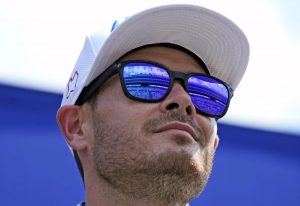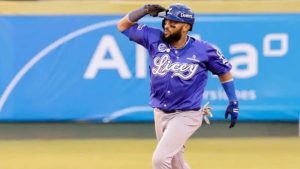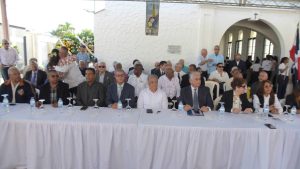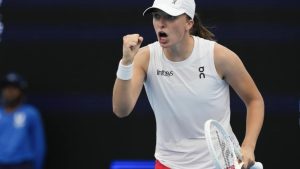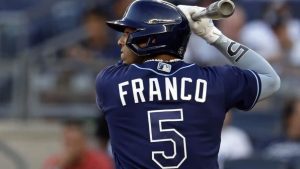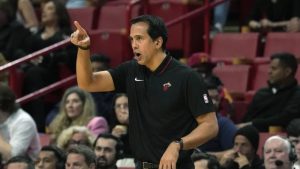How Calvin Booth transitioned from NBA journeyman to Nuggets general manager

Among the six nights separating his first NBA Draft as general manager of the Denver Nuggets and the opening of free agency on June 30 of last year, Calvin Booth took Monte Morris to dinner. The 27-year-old point guard performed admirably as Denver’s floor general while starter Jamal Murray nursed a torn ACL for the 2021-22 season. Even with Murray set to return alongside two-time MVP center Nikola Jokic for this campaign, and despite mounting trade speculation about the man sitting across the table, Booth said he viewed Morris as a key piece of the Nuggets’ chase toward the Western Conference title.
“We talked about what this year looked like, what we need to do, what his role was gonna be,” Booth told Yahoo Sports. “And you realize that … that’s a scenario, frankly, I didn’t keep my word.”
The Nuggets and Wizards had already discussed a deal surrounding the Wizards’ Kentavious Caldwell-Pope during the hours before last February’s trade deadline, when Booth’s predecessor, Tim Connelly, led negotiations with Washington. Booth, 46, had risen through the scouting ranks to Connelly’s trusted second in command and shared the idea Jokic needed more defensive specialists at his side to double as ball movers and perimeter marksmen. Then the week of May’s NBA Draft Combine, as league personnel flocked to Chicago, Timberwolves ownership made Connelly an offer to spearhead Minnesota’s front office that he couldn’t refuse. The league’s unforgiving clock ticked toward draft night anyhow, leaving Booth in pole position of the Nuggets’ basketball operations and overseeing this build around Denver’s generational talent from Serbia.
Sometime after his meal with Morris, Booth reconnected with Wizards general manager Tommy Sheppard. The whole league understood Caldwell-Pope was still available, and a significant fraction of NBA transactions result from groundwork laid during a previous window of activity. Those are the trappings of a fixed marketplace, not to mention an industry ingrained with competition, where a champion is crowned and where dealmakers often repeat talks with trusted allies over unfamiliar foes. Someone trusted like Booth, who is hailed among NBA executives for his constitution as much as his scouting acumen.
“Everyone that he’s touching, everyone likes him,” said Arturas Karnisovas, the Bulls’ executive vice president after spending three years alongside Booth in Denver.
So a sense of dread flooded Booth’s conscience when it became clear Washington was drawing a line in the sand. Morris, and his capability to slot next to All-Star Bradley Beal in the backcourt, was the Wizards’ asking price for the veteran known as KCP, plus longtime Nuggets reserve Will Barton. The son of a cop and a nurse, Booth was doing someone wrong not too long after being awarded his profession’s ultimate power: final say.
“That’s the part of the business that sucks,” Booth told Yahoo Sports. “And I kinda beat myself up about that a little bit. But I learned a lesson from it. You don’t know how these things unfold and you have to watch what you say in those kinda instances. You don’t want those to start to stack up. I already got one of them. If you have three or four or five or six times where it’s like, ‘You said one thing, and then another thing happens,’ that’s where it ends up being the NBA you don’t want to think about.”
A softness fills Booth’s light-green eyes. You can see them searching and scanning underneath his bushy brows as he speaks. There’s quite a difference, after all, between watching and paying attention — studying instead of seeing. “Naturally, I am quiet and observant,” Booth told Yahoo Sports.
And so he shaded the background of locker rooms throughout his nomadic 10-year NBA playing career, after the Wizards drafted the 6-foot-11 Booth out of Penn State with the sixth pick of the second round in 1999. He timed the rare openings when a low-usage giant, with only 366 games to his resume, could speak volumes and actually be heard.
“I probably had cringe-worthy moments,” Booth said, cracking a smile inside his goatee. “I wasn’t afraid to voice my opinion even from a low position, where guys were probably like, ‘Why is this guy talking? He’s not even good. He’s not even playing.’”
Booth saw just 4,447 regular-season minutes over his decade in the league, compared to his hours spent surveying games from the sidelines. Only 240 minutes came over 31 games during his penultimate season in 2007-08, and Booth became fixated on the NBA Draft. He, too, was struck by Derrick Rose’s nightly athleticism at Memphis. He noticed Kevin Love’s pinpoint passing at UCLA. Booth’s foray from journeyman center to pro scout to chief executive of the Nuggets’ front office was far less apparent.
His tenure as a Wizard closed halfway through his second season, when Washington tossed Booth in the outgoing trade package to Dallas headlined by Juwan Howard. Booth posted the best numbers of his career: 7.5 points, 4.8 rebounds, 2 blocks and 1.3 assists in 19.5 minutes over 15 games — all would have marked career-highs over a full campaign.
“I was just an OK NBA player. And that might be the highest of the compliment, if I’m being self-deprecating,” Booth said.
The reserved big man still left an impression on Mavericks staffers, “He’s just a good guy. He’s low-key, smart, diligent, works his ass off,” Dallas owner Mark Cuban told Yahoo Sports. It was the owner’s first full year in control of the franchise, and Cuban, as Cuban does, was overjoyed when his Mavericks reached the 2001 playoffs, drawing the fearsome Jazz duo of Karl Malone and John Stockton to a decisive, first-round Game 5. Cuban fronted a bushel of tickets for Dallas fans to watch in Salt Lake City, where in the waning moments, it was Booth who took center stage.
This was the dawn of Dirk Nowitzki, Steve Nash and Michael Finley ascending into Western Conference contention, “and Calvin Booth came through when it mattered most,” Cuban said. When Finley isolated Stockton just above the right elbow, and the defense collapsed, he found Dallas’ dutiful center waiting patiently along the baseline as a critical safety valve. Booth promptly flipped the series-winning layup through iron with just over 10 seconds remaining.
“A lot of big guys in that situation would have probably turned to the rim, because Finley was really good at that turnaround shot, and just went to the rebound,” Booth said. “All I literally did was keep my eyes open. That was the only thing that took any kind of extra talent.”
After Utah’s two attempts went wide on the other side of the floor, Cuban and the Mavericks’ entire bench sprinted around the court like a scene ripped from March Madness.
His first trade delivered Booth a career highlight, and that summer brought Booth’s first taste of free agency. Seattle spied a 25-year-old rim protector in need of a long-term home, and rewarded Booth with a six-year, $34 million deal. He learned quickly how valuable ingredients can become, when a franchise already holds a straw that stirs their drink.
“I didn’t get paid because I was that good. I got paid because of Steve Nash,” Booth said. “Dallas was a platform to let people see the motor, the work and playing with Dirk and Finley. But Nash was orchestrating everything. I think there are certain players that come through, and even some coaches, but you could start a list of guys that those players got contracts for. And I’m on Nash’s list.”
Booth never blossomed into the SuperSonics’ center of the future, remaining more of a steady presence than a game-changing force. Then-Seattle head coach Nate McMillan found the Penn State product a necessary resource on his bench.
“He could play with anybody because he had a high basketball IQ,” McMillan told Yahoo Sports. “He had a feel for the game and for his teammates.”
Rashard Lewis, a Seattle starter, recalled Booth’s studious nature in film sessions, delivering questions and observations that expanded the game’s geometry.
“Observers are very intelligent,” said Antonio Daniels, another Sonics teammate. “He was a watcher. Let me watch, let me see. ‘OK, this is what they’re doing? Let me watch how to attack it, how to scheme against it.’”
Booth returned to the postseason in 2007, after he rejoined the Wizards the season before. That second stint in Washington also reunited Booth with the charismatic assistant video coordinator he’d befriended during his rookie season. A young Connelly had grown into the Wizards’ director of player personnel. Their connection formed over a mutual thrill for ideas, and the budding executive began inviting Booth on scouting trips whenever his playing schedule allowed.
They flew to Ireland for a program called Show Racism the Red Card in which Booth and fellow Wizards player Roger Mason Jr. worked with lrish prospects. Booth won over locals while winning hand after hand at Dublin poker houses. Their player evaluations also took them to Belfast and Treviso, Italy. “He immersed himself in local culture,” Connelly said. “He’s very intellectually curious.” Booth offered book recommendations for their flights, pitching Connelly on some authors’ new theories about subject matter beyond the sport.
It was the 2008 Treviso Eurocamp, that next spring, which crystalized Booth’s faculty for the front office. He glued his gaze to the court, the same stare as if he was readying to hear his name called for action.
“It was just cool how much he loved to be in the gym and scouting,” Connelly said. “It wasn’t a chore to him.”
Having burned through footage of top collegiate prospects like Russell Westbrook and Brook Lopez, a 76ers bench big moonlighting as an evaluator, this event brought Booth’s first glimpse of Goran Dragic, Serge Ibaka and Nicolas Batum. The scouting community held varying opinions on the French swingman, but Booth was strong in his conviction that Batum would find his footing in the very league Booth scrutinized for a decade.
“I just knew how he moved and looked like an NBA player, with his decision-making, and he was a very good athlete,” Booth said.
Talent is easy to qualify, but it is the ability to quantify — and project — that separates a draft find from a true steal. “It was obvious, he’s got a great eye for talent,” Connelly said. Batum was the 25th pick in that draft, but he has contributed the seventh most win shares of that entire class.
Booth resisted a full-time scouting life when he first retired. He made camp in Columbus, Ohio, coaching teenagers during summer circuits and decided building an AAU program was the ideal outcome to further those players’ growth. He drove down to Cleveland twice a week to lead practices.
“I wanted to see what would happen if you really went about creating a program and developing guys the right way,” Booth said. He enlisted a small design shop in North Carolina to create his team’s Wolfpack logo and uniforms from scratch. “There wasn’t any Hollywood ending where we had a 6-9 guy who ended up in the NBA,” Booth said. “But we had a really good group of kids that I really enjoyed coaching and everyone” — including Booth — “got better.” Today, Booth credits Andreas James, a former Division II All-American point guard, for ballooning his Nova Village program to over 40 teams.
On the side, Booth began scouting for an independent service run by Jim Clibanoff, a Philadelphia native with a penchant for finding prospects who sent several NBA and international teams detailed reports and scouting information from traveling evaluators like Booth. It wasn’t long before Connelly, who had become Dell Demps’ right hand during his tenure in New Orleans, snatched Booth for the Pelicans’ front office as a pro personnel scout. What began with driving to Canton for Charge G League games and Cleveland for Cavs games and Detroit for Pistons games became a steady march up the NBA ladder. He moved on to the Timbewerwolves and became Minnesota’s director of player personnel. When the Nuggets elevated Connelly to team president in 2017, to help keep Karnisovas on board as general manager at the time, Denver brought Booth on board as an assistant GM, too.
“He has already a level of discipline to be on 10 teams and experience dealing with multiple coaches, players, relationships. I think that experience is great,” Karnisovas told Yahoo Sports. «But at the same time, when you finish your career and scouting, you’re starting from zero. He worked his way up and he knows what it takes on every level.”
Those early days in Denver, Karnisovas would sometimes get to Lifetime Fitness at 7 a.m. because it was closer to home than the Nuggets’ facility for an early workout. Booth was often already there, drilling his son, Carey, at different spots on the floor.
Booth’s daughter, Carter, has blossomed into a strong middle blocker at the University of Minnesota.
There has been no roadmap for Booth’s teaching, other than uplifting his children as he did for those in Nova Village all those years ago. There is no Booth-shaped stencil that worked for his own career, but a focus on general tenets of the game. That perspective, Booth believes, has been central to his shift from playing to evaluating.
“I’ve worked a lot with my son and people are like, ‘Oh, does he play like you?’ And I’m like, no. It’s way different. He’s more like Rashard Lewis than he’s like me,” Booth said. “So if anything, some of the players, especially better ones, they have a healthy ego about who they were as players. I was able to separate my views about basketball, how I thought about basketball, from my own personal playing experience.”




